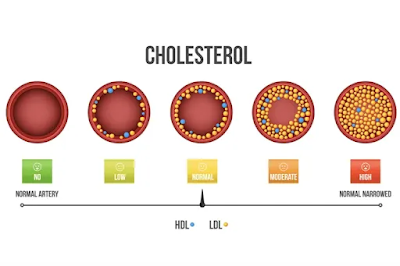DR. MOHSINA
P.G. SCHOLAR
DEPARTMENT OF ANATOMY
STATE TAKMEEL-UT-TIB COLLEGE & HOSPITAL
LUCKNOW, INDIA
Cholesterol is the principal sterol of all
higher animals, distributed in body tissues, especially the brain and spinal
cord, and in animal fats and oils. Elevated cholesterol in the blood,
especially when bound to low-density lipoprotein (LDL, often called "bad
cholesterol"), may increase the risk of cardiovascular disease.
Statins are usually used to lower blood
cholesterol levels and reduce the risk for atherosclerosis-related illnesses,
such as cardiovascular disease.
Statins have been suggested to increase
retinal and choroidal blood flow, protect retinal ganglion cells in the setting
of ischemia, and lower IOP, and they have been investigated as neuroprotective
agents outside their primary indication as anti-hypercholesterolemic agents.
The cross-sectional, population-based study
involved 79,742 adult participants aged ≥ 40 years with hyperlipidemia enrolled
in the AoU database.
Of the 79,742 individuals with
hyperlipidemia in AoU, there were 6,365 (8.0%) statin users.
Statin use was associated with increased
glaucoma prevalence when compared with statin non-use (adjusted odds ratio
[aOR]: 1.13, 95% confidence interval [CI]: 1.01-1.26).
Higher serum levels of LDL were associated
with increased odds of glaucoma (aOR: 1.003, 95% CI: 1.003, 1.004).
Statin users had significantly higher LDL
levels in comparison to the nonusers (144.9 mg/dL versus 136.3 mg/dL, p-value
< 0.001).
Analysis stratified by LDL identified
positive associations between statin use and prevalence of glaucoma among those
with optimal (aOR = 1.39, 95% CI = 1.05-1.82) and high (aOR = 1.37, 95% CI =
1.09-1.70) LDL levels.
Age-stratified analysis showed a positive
association between statin use and the prevalence of glaucoma in individuals
aged 60-69 years (aOR = 1.28, 95% CI = 1.05-1.56).
CONCLUSIONS:
The study concluded that statin use was
associated with increased glaucoma likelihood in the overall adult AoU
population with hyperlipidemia, in individuals with optimal or high LDL levels,
and individuals 60-69 years old. Findings suggest that statin use may be an
independent risk factor for glaucoma, which may furthermore be affected by
one’s lipid profile and age.
REFERENCE:
Lee SY, Paul ME, Coleman AL, Kitayama K, Yu
F, Pan D, Tseng VL. Associations between Statin Use and Glaucoma in the All of
Us Research Program. Ophthalmol Glaucoma. 2024 Jul 31:S2589-4196(24)00137-6.
doi: 10.1016/j.ogla.2024.07.008. Epub ahead of print. PMID: 39094953.








No comments:
Post a Comment